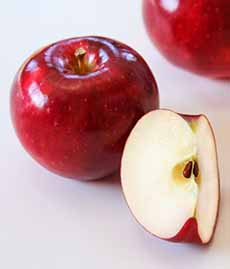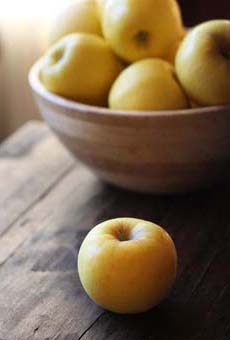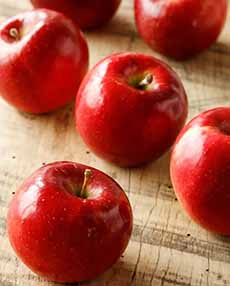|
National Apple Week begins the second Sunday of the first full week in August*.
Our tip: Try a different type of apple than your regular two or three favorites.
You might have to look beyond your supermarket to farmers markets, but it’s well worth your time.
MORE APPLE HOLIDAYS
> National Johnny Appleseed Day is March 11th and also September 26th.
> National Apple Pie Day is May 13th.
> National Sugarbee Apple Day is May 20th.
> National Applesauce Day is June 6th.
> National Apples Strudel Day is June 17th.
> National Apple Turnover Day is July 5th.
> National Apple Dumpling Day is September 17th.
> National Eat An Apple Day is the third Saturday in September.
> National Apple Month is October.
> National Applejack Month is October.
> National Apple Betty Day is October 5th.
> National Apple Day is October 21st.
> National Caramel Apple Day is October 31st.
> National Eat A Red Apple Day is December 1st.
> The top 10 apple varieties.
> The history of apples.
NEW APPLE TYPES
Breeders are always seeking the next great thing: an apple that will capture the hearts and palates of consumers.
These new varieties were bred to be eating apples, also known as dessert apples and table apples. Two of the five can also be used for cooking.
Enjoy these apples as hand fruit, with cheese, sliced into green salads and fruit salads, diced into a yogurt parfait, make apple slaw, apple salsa and yesterday’s pickled apples recipe.
Cosmic Crisp, an easier-to-grow alternative to Honeycrisp, bred at Washington State University, is super crunchy, sweet-tart in flavor—plus, it’s slow to brown. It’s a cross between Honeycrisp and Enterprise apples. (We had some and they were spectacular, although were sold out when we returned for more.)
Juici, a cross between Honeycrisp and Braeburn, is more complex than Honeycrisp, with great crunch. It can also be baked.
Piñata, a cross between Cox’s Orange Pippin, Duchess of Oldenburg and Golden Delicious, was bred in Germany. It’s targeted to people who like Fuji and Gala varieties. It is also marketed as Corail, Pinova and Sonata.
RubyFrost, bred at Cornell University, is a cross between Golden Delicious and Topaz. It’s sweet and extra crunchy, and resists browning. It can also be used for baking.
Opal, bred in the Czech Republic, is a cross between Golden Delicious and Topaz, is more flavorful (and more colorful) than the Golden Delicious.
There are more newbies varieties, of course. Here are some others you may find in your local markets.
It Takes A Long Time To Develop A New Apple
It takes more than 10 years—often 20 or even 30—between when a new cultivar is bred and when it is released to consumers (Here’s why). For example:
Cosmic Crisp was first cultivated by Washington State University in 1997 but wasn’t didn’t come into the national marketplace until the end of 2019.
Honeycrisp, one of the most popular newer varieties, a cross between the Honeygold and the Macoun, was created in 1960 at the University of Minnesota but not released until 1991 [source]. The Honeygold itself is a cross between a Golden Delicious and a Haralson.
Why does apple breeding take so long? It’s a lot of trial and error: planting trees, waiting for fruit to grow, and repeating until the ideal result is achieved.
Apple Trivia: Apples’ durability is a marvel of nature. Harvested in from July through October, most apples are then put into a controlled climate, awaiting release through the year.
That’s why you can purchase numerous types of apples year-round. During the off seasons, you’re actually buying apples that are up to a year old, and you barely notice (and that’s why in the spring and early summer, they may taste a bit less than prime [source]).
|
|

[1] Cosmic Crisp is our new favorite apple. Its name comes from the yellow dots (lenticels) on the skin, which hint at stars in the night sky (photo © Proprietary Variety Management).

[2] Opal apples, a cross between Golden Delicious and Topaz, were bred in the Czech Republic (photo © Golden Sun Marketing).

[3] RubyFrost: sweet and tart, crisp and crunchy. Eat it or bake it (photo © Crunch Time Apple Growers | Matt Wittmeyer).

[4] America’s top-selling apples (chart © U.S. Apple).
|
APPLE HISTORY
Apples, seemingly the all-American fruit, actually originated in Central Asia: in southern Kazakhstan, Kyrgyzstan, Tajikistan and Xinjiang, in northwest China.
Apples were introduced to North America by colonists in the 17th century. The first apple orchard on the continent was planted in Boston in 1625, by Reverend William Blaxton.
Here’s more about the history of apples.
APPLE TRIVIA
Apples are a member of the rose family, Rosaceae, which, in addition to flowering plants, also includes almonds, apricots, cherries, loquats, peaches, pears, plums, quinces, raspberries, and strawberries.
More than 2,500 varieties of apples are grown in the United States, 200 commercially (see photo #4 for the Top 10 apples). Only the crabapple is native to North America. Some 7,000 varieties exist worldwide.
The top apple producers around the world are China, the United States, Turkey, Poland, and Italy.
Apples account for 50% of international deciduous fruit tree production.
Seventy percent of American apples are grown in Washington State.
APPLE RECIPES FOR NATIONAL APPLE WEEK
Apple Balsamic Salmon
Apple Dumplings
Apple Ginger Cole Slaw
Apple Pie Oatmeal
Apple Sangria
Applesauce Cake
Apple Streusel Bundt Cake
Apple Turnovers
Apple Walnut Chutney
Caramelized Onion & Apple Galette
Classic Apple Crisp
Homemade Applesauce
Pork Fajitas With Apple Cilantro Salsa
Roasted Beet, Avocado and Granny Smith Apple Towers
Salted Apple Caramel Cheesecake
Sour Cream Walnut Apple Pie
Sweet & Spicy Pickled Apples
Turkey Salad With Celery Root & Apples
________________
*According to A Healthier Michigan, the first full week in August is National Apple Week. We can’t find other references for this holiday; nevertheless, we’re more than happy to celebrate National Apple Week now. National Apple Month is October and National Apple Day is October 21st.
†Some popular varieties that do not store well are imported from the Southern Hemisphere, where the seasons are reversed.
CHECK OUT WHAT’S HAPPENING ON OUR HOME PAGE, THENIBBLE.COM.
|






